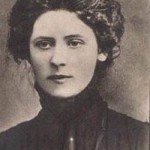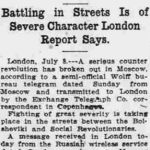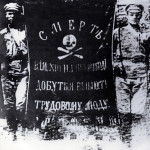
When the Bolsheviks seized control of Petrograd in October 1917, they were supported by the Left SRs, a small but influential revolutionary group. As their name suggests, the Left SRs once belonged to the Socialist Revolutionary party, which until the revolution had been Russia’s largest left-wing political party. But the events of 1914-17 proved divisive and destructive for the Socialist Revolutionary movement. Populist and broad-based, the SRs had always contained a wide range of political views, along with conservative, moderate and radical factions. The onset of World War I further exposed these political fractures within the SR party, which was divided about how to respond. The majority of SRs favoured supporting the war effort, either as a patriotic gesture or a defensive measure- but the party’s radical left adopted an anti-war position, similar to that of the Bolsheviks. Several SR leaders became ministers in the Provisional Government during 1917 but their continued support for the war, along with the lack of progress on land reform and redistribution, led the Left SR faction to align with the Bolsheviks.
The split in the SR movement was finalised by the events of October 1917. Dozens of Left SRs contributed to preparations for the overthrow of the Provisional Government – in fact, the chairman of the Military Revolutionary Committee, Pavel Lazimir, was a Left SR rather than a Bolshevik. On October 26th, when the Second Congress of Soviets was told that Red Guards had arrested the Provisional Government and seized power on their behalf, moderate SR delegates stormed out of the building – at which point they were famously consigned to the “dustbin of history” by Leon Trotsky. The Left SR delegates chose to remain, a decision that led to their expulsion from the broader SR organisation, after which they formed their own independent party. From this point, the Left SRs were aligned with the Bolsheviks. Shortly after the October takeover, Lenin offered them a role in a coalition government but the Left SRs wanted a Soviet-based government – a “united revolutionary front”, one called it – and rejected the offer. In early December they changed their minds and formed a coalition government with the Bolsheviks, accepting seven portfolios in the Sovnarkom.
“The Left SRs were hardly less radical than the Bolsheviks themselves (they tended to stress peasant interests)… It is nevertheless possible that over a period of years, the coalition could have led to mutual restraint, which might in due course have mitigated the worst features of totalitarianism … It soon became clear, however, that the Bolsheviks did not want to share power with any party.”
Dmitri Volkogonov, historian
The de facto leader of the Left SRs during this critical period was Maria Spiridonova, a young female activist who had once murdered a tsarist police commander on his doorstep. Under Spiridonova the Left SRs supported most of the Bolshevik programme, though some significant points of difference were exposed and teased out during the first weeks of 1918. Land reform, reorganisation of the peasantry and rural self-sufficiency remained at the forefront of the Left SR agenda; Lenin, however, rejected these policies as “bourgeois-tinted dreams”. Of greater concern to some Left SRs was the exclusion of non-Bolshevik socialist and Soviet voices from government. Left SR leaders opposed the closure of the Constituent Assembly, though they were outnumbered and thus outvoted by the Bolsheviks. The extra-legal violence and intimidation wielded by the emerging CHEKA was accepted as necessary by some Left SRs but condemned by others. Isaac Steinberg, the Left SR lawyer who served as commissar for justice in the first Sovnarkom, regularly criticised the CHEKA and called for an inquiry into its conduct, with no success.

The fragile alliance between the Bolsheviks and the Left SRs was brought to an end by the Treaty of Brest-Litovsk. The Left SRs considered the March 1918 treaty to be treacherous, a “sell-out” filled with cruel disregard for Russian peasants living in affected territories, and they opposed it intensely. Once the Bolsheviks had accepted and ratified the Brest-Litovsk agreement, the Left SRs withdrew from the Sovnarkom, leaving it entirely in Bolshevik hands. They continued to participate in the Congress of Soviets, however, the opportunistic measures taken by the Bolsheviks in 1918 widened the rift between the two parties. Among the Bolshevik policies bitterly opposed by the Left SRs were the imposition of state control in factories; the restoration of the death penalty; and the introduction of war communism. In the spring of 1918, the German army occupied Ukraine and violently suppressed peasant opposition there, while the Bolshevik government did nothing. The outraged Left SRs lobbied the Fourth Congress of Soviets (July 1918) to have the Treaty of Brest-Litovsk nullified, calling for a new declaration of war against Germany. The motion was defeated by the Bolshevik majority.

The following day the Left SRs took action into their own hands, sending agents to assassinate the German ambassador, Count Mirbach, in Moscow. Inspired by this success, a brigade of soldiers loyal to the Left SRs defied the Bolsheviks, refusing orders and even detaining Felix Dzerzhinsky, head of the much-feared CHEKA. The rebels held the upper hand in Moscow, where their troops outnumbered soldiers loyal to the Bolsheviks by almost three to one. With the city’s workers unwilling to defend the Bolsheviks, the Left SRs and their troops might have swept into the Kremlin to arrest Lenin and other members of the government. But the Left SR uprising was a spontaneous event: unlike the Bolsheviks in October 1917, their leaders had made no planning or provision for a takeover.
Though it took several days, the SR revolt was eventually crushed by Red Army and CHEKA reinforcements. Around 950 Left SRs were hunted down, arrested and given a show trial in late 1918, though they were treated with comparative leniency, with only 13 given short sentences in Soviet labour camps. Maria Spiridonova herself was sentenced to just one year in prison. The onset of the Civil War and the widening of the Red Terror soon produced tougher measures. The Left SR party was declared illegal in February 1919 and Spiridonova was arrested again shortly after, for publicly criticising the government. Other individual Left SRs were chased into exile, where they fought with peasant militias against the Red Army during the Civil War; some withdrew from political life but later agitated against the Bolsheviks in the early 1920s. As a political party, the Left SRs quickly faded into political oblivion. Their bold attempt to initiate a ‘third Russian Revolution’, mirroring the events of October 1917, was the last concerted stand against Bolshevism until 1921.

1. The Left SRs were a radical faction of the Socialist Revolutionary party. Like the SRs they wanted land reform and worker control, however, the Left SRs employed terrorism to achieve their goals.
2. The Left SRs moved away from the mainstream Socialist Revolutionary party in 1914-17, mainly because of its support for the Russian war effort in World War I.
3. In 1917 the Left SRs broke with the SRs, aligned with the Bolsheviks and participated in the October Revolution.
4. Left SR leaders later joined the Soviet government but walked out in objection to the Treaty of Brest-Litovsk.
5. In July 1918 the Left SRs murdered the German ambassador and launched a spontaneous attempt to seize control of Moscow and other Russian cities – but this uprising was unplanned and disorganised, so was quickly suppressed.
© Alpha History 2018. Content on this page may not be republished or distributed without permission. For more information please refer to our Terms of Use.
This page was written by Jennifer Llewellyn, John Rae and Steve Thompson. To reference this page, use the following citation:
J. Llewellyn et al, “The Left SRs” at Alpha History, https://alphahistory.com/russianrevolution/left-srs/, 2018, accessed [date of last access].
